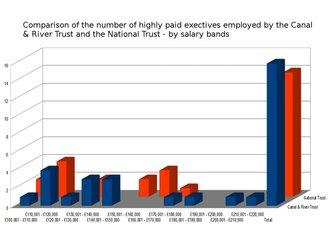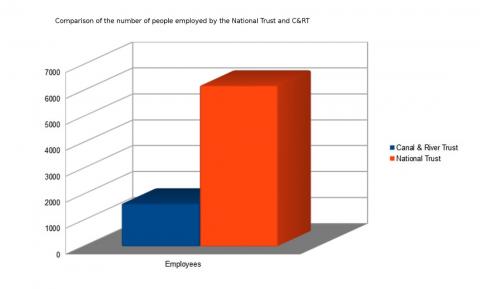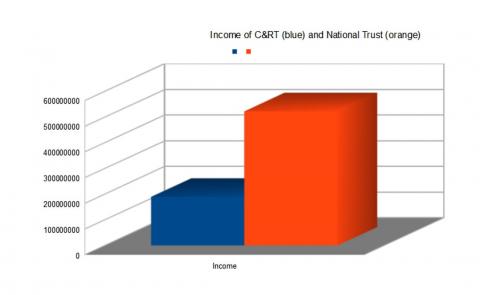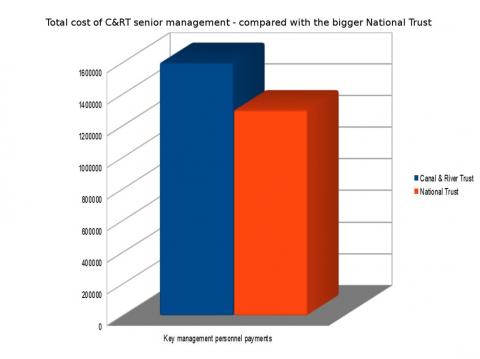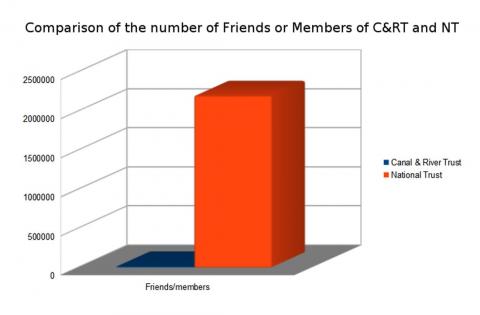Too many chiefs at C&RT?
March 2017 - Allan Richards has been taking a look at the management costs of the National Trust and the Canal & River Trust and the ever-expanding top management of C&RT gives rise to some serious questions
Leaving aside its 11 trustees, why does Canal & River Trust (C&RT) have nine highly paid executive directors? In 2012, it only had six.
Now it has three more but it is difficult to see what has changed that increases the need for executive directors with remuneration packages ranging from over £100,000 to more than £200,000.
When British Waterways became C&RT back in 2012, six BW directors transferred to the new charity. They were Robin Evans (chief executive), Nigel Johnson (corporate services director), Stuart Mills (property & enterprise director) Vince Moran (technical & operations director), Philip Ridal (finance director) and Simon Salem (marketing director).
Five years on all but Stuart Mills have 'stepped down' taking with them substantial redundancy payments and pension entitlements. The latest, nine strong, executive team consists of Richard Parry (chief executive), Sandra Kelly (finance & corporate services director), Sophie Castell (marketing, communications and fundraising director), Mike Gooddie (human resources director), Stuart Mills, (job title now property director), Ian Rogers (customer services and operations director), Julie Sharman (asset management director), Simon Bamford (asset delivery director), Heather Clarke (strategy & planning director).
Heather Clarke - Responsible for strategy, public policy, research and measurement, strategic performance and reporting, spatial and statutory planning functions, and planning and urban design
If one assumes that the functions of chief executive and property director have remained largely the same, we now have seven directors carrying out the functions performed by just four directors a few years previously.
Turning to the subject of remuneration, BW used to disclose details of all director's pay including bonus payments, benefits and bonuses in annual reports. Any information not disclosed could be obtained by request.
Unfortunately, C&RT only provide a subset of this information and refuse requests for further details.
C&RT was promoted as the new 'National Trust of the Waterways' thus positioning it alongside the National Trust as a charity protecting and maintain historic infrastructure.
It is reasonable, therefore, to provide a comparison of number of staff that fall into pay bands above £100,000 for the two charities (figures taken from latest annual reports) -
C&RT NT
£100,001 - £110,000 1 2
£110,001 - £120,000 4 4
£120,001 - £130,000 1 0
£130,001 - £140,000 3 2
£140,001 - £150,000 3 0
£150,001 - £160,000 0 2
£160,001 - £170,000 0 3
£170,001 - £180,000 1 1
£180,001 - £190,000 1 0
£190,001 - £200,000 0 0
£200,001 - £210,000 1 0
£210,001 - £220,000 1 0
Total 16 14
NT has four times the employees of C&RT. Its income is well over two and a half times that of C&RT (despite not having the benefit of government grant and property portfolio).
Its membership figures, compared to C&RT's, speak for themselves. However, it manages to pay its executives less than C&RT and with its top earner being paid some £40,000 less than C&RT's top earner.
C&RT's first annual report does not provide a figure for key management personnel payments for 2012/13. However, with 11 staff, rather than 16, earning £1000,000+ it will have been significantly less.
There seems to be no logical reason why the number of 'chiefs' and 'high earners' has increased significantly over the five years of the trust's existence.
However, the phrase 'too many chiefs, not enough Indians' appears to be only half vindicated because the number of Indians has risen as well!
In 2012/13 C&RT employed 1,512. Just three years later, despite continuing outsourcing, the number has risen by 10 per cent to 1,660. Worse still, salary costs have jumped by an average of seven per cent each year since 2013 (£42.5m - £51.4m).
And they are still recruiting. Excluding 'chuggers' C&RT are currently advertising some 21 positions. These include some low paid customer facing roles.
For example, a Waterway Operative on a starting salary of £16,471 (with progression) and a Seasonal Attractions Boat Master at £13,894 pro rata.
Somewhat higher up in terms of salary but with less face to face customer contact we have -
* a Head of Boating up to £65,000 (with the advert claiming 37,000 boating customers instead of 32,000!),
* a PA to CEO Richard Parry at circa £36,000
* a 'Portfolio Manager' at circa £45,000
* a PA to director Simon Bamford circa £30,000
* a Community Delivery & Reporting Manager up to £42,000,
* a Development & Engagement Manager at circa £31.00
* a Principal Engineer (Bridges) at circa £45,000
* an Enterprise Manager at circa £42,000
* a Civil Engineer at circa £35,000
Perhaps it's a case of 'too many chiefs' requiring more Indians to justify their existence.
Photos: (1st) Heather Clarke - Responsible for strategy, public policy, research and measurement, strategic performance and reporting, spatial and statutory planning functions, and planning and urban design, (2nd) Ian Rogers - Appointed Customer Services director in January 2015 to support 10-year strategy, (3rd) Julie Sharman - As Asset Management Director gets to wear a hard hat and get out on site at least once a month, (4th) Mike Gooddie Human Resources Director - New boy! Ex-ASDA (as is chair, Allan Leighton), (5th) Stuart Mills - Property Director and only ex-BW director, (6th) Richard Parry - £189,847 + £10,730 pension scheme contribution, (7th) Sophie Castell - marketing, communications and fundraising director. Admits she will fail to deliver on latest 'Friends' target of 22,500, (8th) Sandra Kelly - Replaced Philip Ridal two years ago following poor BWML financial returns, (9th) Simon Bamford - asset delivery director, (10th - 14th) Comparisons between CRT and The National Trust, (15th) more job vacancies at CRT.















